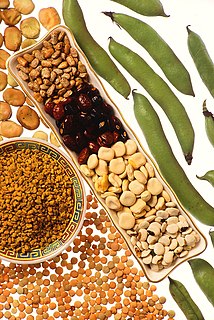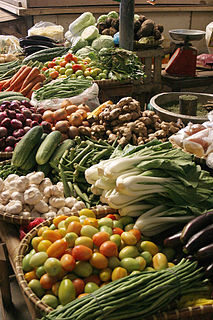Related Research Articles

A legume is a plant in the family Fabaceae, or the fruit or seed of such a plant. When used as a dry grain, the seed is also called a pulse. Legumes are grown agriculturally, primarily for human consumption, for livestock forage and silage, and as soil-enhancing green manure. Well-known legumes include beans, soybeans, peas, chickpeas, peanuts, lentils, lupins, mesquite, carob, tamarind, alfalfa, and clover. Legumes produce a botanically unique type of fruit – a simple dry fruit that develops from a simple carpel and usually dehisces on two sides.

The mung bean, alternatively known as the green gram, maash٫ mūng, monggo, or munggo (Philippines), is a plant species in the legume family. The mung bean is mainly cultivated in East, Southeast and South Asia. It is used as an ingredient in both savoury and sweet dishes.

Vegetables are parts of plants that are consumed by humans or other animals as food. The original meaning is still commonly used and is applied to plants collectively to refer to all edible plant matter, including the flowers, fruits, stems, leaves, roots, and seeds. An alternative definition of the term is applied somewhat arbitrarily, often by culinary and cultural tradition. It may exclude foods derived from some plants that are fruits, flowers, nuts, and cereal grains, but include savoury fruits such as tomatoes and courgettes, flowers such as broccoli, and seeds such as pulses.
In biology, the BBCH-scale for beans describes the phenological development of bean plants using the BBCH-scale.
In biology, the BBCH-scale for bulb vegetables describes the phenological development of bulb vegetable plants, such as onion, leek, garlic and shallot, using the BBCH-scale.
In biology, the BBCH-scale for canola describes the phenological development of canola plants using the BBCH-scale.
In biology, the BBCH-scale for coffee describes the phenological development of bean plants using the BBCH-scale.
In biology, the BBCH-scale for cotton describes the phenological development of cotton plants Gossypium hirsutum using the BBCH-scale.
In biology, the BBCH-scale for faba beans describes the phenological development of faba beans using the BBCH-scale.
In biology, the BBCH-scale for musaceae describes the phenological development of musaceae using the BBCH-scale.
The BBCH-scale (potato) identifies the phenological development stages of a potato. It is a plant species-specific version of the BBCH-scale.
The BBCH-scale (rice) identifies the phenological development stages of rice Oryza sativa. It is a plant species specific version of the BBCH-scale.
The BBCH-scale identifies the phenological development stages of solaneous fruit. It is a plant species specific version of the BBCH-scale.
The BBCH-scale (sunflower) identifies the phenological development stages of the sunflower. It is a plant species specific version of the BBCH-scale.
The BBCH-scale (weed) identifies the phenological development stages of weed species. It is a plant species specific version of the BBCH-scale.
In biology, the BBCH-scale for leafy vegetables forming heads describes the phenological development of leafy vegetables forming heads, such as cabbage, chinese cabbage, lettuce and endive, using the BBCH-scale.
In biology, the BBCH-scale for leafy vegetables not forming heads describes the phenological development of leafy vegetables not forming heads, such as spinach, loosehead lettuce, and kale, using the BBCH-scale.

Intensive crop farming is a modern industrialized form of crop farming. Intensive crop farming's methods include innovation in agricultural machinery, farming methods, genetic engineering technology, techniques for achieving economies of scale in production, the creation of new markets for consumption, patent protection of genetic information, and global trade. These methods are widespread in developed nations.

Ditylenchus dipsaci is a plant pathogenic nematode that primarily infects onion and garlic. It is commonly known as the stem nematode, the stem and bulb eelworm, or onion bloat. Symptoms of infection include stunted growth, discoloration of bulbs, and swollen stems. D. dipsaci is a migratory endoparasite that has a five-stage lifecycle and the ability to enter into a dormancy stage. D. dipsaci enters through stomata or plant wounds and creates galls or malformations in plant growth. This allows for the entrance of secondary pathogens such as fungi and bacteria. Management of disease is maintained through seed sanitation, heat treatment, crop rotation, and fumigation of fields. D. dipsaci is economically detrimental because infected crops are unmarketable.
Cereal growth staging scales attempt to objectively measure the growth of cereals.
References
- ↑ Meier, U. (2001). "Growth stages of mono- and dicotyledonous plants". BBCH Monograph. doi:10.5073/bbch0515. Archived from the original on 2018-10-15. Retrieved 2018-10-15.
- ↑ Zadoks, J.C.; T.T. Chang; C.F. Konzak (1974). "A decimal code for the growth stages of cereals". Weed Research. 14 (6): 415–421. doi:10.1111/j.1365-3180.1974.tb01084.x.
- ↑ "E-Notes". E-Notes.